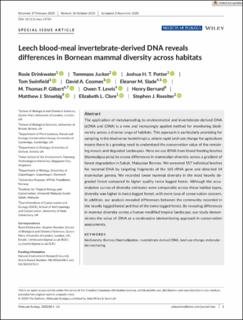| dc.contributor.author | Drinkwater, Rosie | |
| dc.contributor.author | Jucker, Tommaso | |
| dc.contributor.author | Potter, Joshua H. T. | |
| dc.contributor.author | Swinfield, Tom | |
| dc.contributor.author | Coomes, D | |
| dc.contributor.author | Slade, Eleanor M. | |
| dc.contributor.author | Gilbert, Marcus Thomas Pius | |
| dc.contributor.author | Lewis, Owen T. | |
| dc.contributor.author | Bernard, Henry | |
| dc.contributor.author | Struebig, Matthew J. | |
| dc.contributor.author | Clare, Elizabeth | |
| dc.contributor.author | Rossiter, Stephen J. | |
| dc.date.accessioned | 2021-03-25T07:24:34Z | |
| dc.date.available | 2021-03-25T07:24:34Z | |
| dc.date.created | 2021-03-24T12:51:43Z | |
| dc.date.issued | 2020 | |
| dc.identifier.citation | Molecular Ecology. 2020, . | en_US |
| dc.identifier.issn | 0962-1083 | |
| dc.identifier.uri | https://hdl.handle.net/11250/2735375 | |
| dc.description.abstract | The application of metabarcoding to environmental and invertebrate‐derived DNA (eDNA and iDNA) is a new and increasingly applied method for monitoring biodiversity across a diverse range of habitats. This approach is particularly promising for sampling in the biodiverse humid tropics, where rapid land‐use change for agriculture means there is a growing need to understand the conservation value of the remaining mosaic and degraded landscapes. Here we use iDNA from blood‐feeding leeches (Haemadipsa picta) to assess differences in mammalian diversity across a gradient of forest degradation in Sabah, Malaysian Borneo. We screened 557 individual leeches for mammal DNA by targeting fragments of the 16S rRNA gene and detected 14 mammalian genera. We recorded lower mammal diversity in the most heavily degraded forest compared to higher quality twice logged forest. Although the accumulation curves of diversity estimates were comparable across these habitat types, diversity was higher in twice logged forest, with more taxa of conservation concern. In addition, our analysis revealed differences between the community recorded in the heavily logged forest and that of the twice logged forest. By revealing differences in mammal diversity across a human‐modified tropical landscape, our study demonstrates the value of iDNA as a noninvasive biomonitoring approach in conservation assessments. | en_US |
| dc.language.iso | eng | en_US |
| dc.publisher | Wiley | en_US |
| dc.rights | Navngivelse 4.0 Internasjonal | * |
| dc.rights.uri | http://creativecommons.org/licenses/by/4.0/deed.no | * |
| dc.title | Leech blood-meal invertebrate-derived DNA reveals differences in Bornean mammal diversity across habitats | en_US |
| dc.type | Peer reviewed | en_US |
| dc.type | Journal article | en_US |
| dc.description.version | publishedVersion | en_US |
| dc.source.pagenumber | 14 | en_US |
| dc.source.journal | Molecular Ecology | en_US |
| dc.identifier.doi | 10.1111/mec.15724 | |
| dc.identifier.cristin | 1900622 | |
| cristin.ispublished | true | |
| cristin.fulltext | original | |
| cristin.qualitycode | 2 | |

